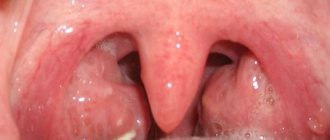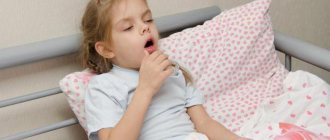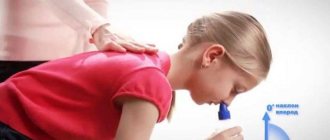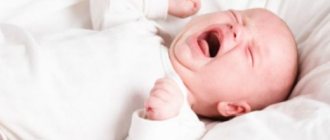After infectious and inflammatory processes, children often develop residual effects, the most common of which is cough. Such a symptom can have varying degrees of severity, bother you every day, and cause considerable discomfort to the baby. It is necessary to treat residual cough in a child qualitatively, adhering to all the doctor’s recommendations. Failure to take this pathology seriously can lead to deterioration of the respiratory system and the development of various diseases .
Why do children have a residual cough?
Residual cough often develops against the background of the following experienced by the young patient:
- ARVI.
- Bronchitis.
- Pneumonia.
After intensive drug therapy, often including antibiotics, the child’s body is weakened and needs a certain period of time to recover.
During the rehabilitation period, the bronchi “turn on” a special protective mechanism - cough, the purpose of which is to prevent blockage of the airways with mucus or purulent masses.
Causes
Cure an infectious disease, pneumonia or bronchitis - the first steps on the path to recovery. After taking medications and antibiotics, the child’s body is weakened and needs time to recover. Residual cough is a protective mechanism that sensitive bronchi use, preventing complete blockage of the airways with mucus, pus, and sputum.
Residual symptoms after a recent illness are often the norm, not an abnormality. This is due to excessive sensitivity of the bronchi. It takes time for a child’s body to restore its immunity.
The consequences of the activity of viruses still continue to irritate the mucous membrane, it is inflamed, and it takes time to recover.
With proper therapy, this condition should go away in two to three weeks. In most cases, residual effects are a natural process of clearing the airways.
Among other causes of cough that occur in the absence of fever, it is worth highlighting:
- relapse of the inflammatory process;
- reaction of the respiratory system to cold air;
- too much physical activity;
- allergic reactions to wool, dust, tobacco;
- stress, nervousness;
- penetration of a foreign body into the respiratory tract and others.
Sometimes this symptom may indicate the occurrence of complications. If a child’s cough continues for a long time after an illness, it should be shown to a doctor.
At this moment, the main thing is to determine where the development of complications begins, and where the baby is susceptible to residual effects.
Only a specialist can make an accurate diagnosis, as well as prescribe appropriate treatment if necessary.
How long does this condition last?
After an illness associated with damage to the respiratory system, the appearance of a residual cough is often considered normal. Doctors begin to talk about pathology if this symptom is observed for longer than 2-3 weeks.
Prolonged residual cough can be caused by:
- poorly treated viral infections;
- allergic reactions;
- frequent inhalation of cold air;
- chronic pathologies of ENT organs;
- helminthic infestations;
- cardiac disorders;
- increased nervous excitability;
- the presence of a foreign object in the respiratory tract;
- chest injuries.
A common consequence of antibiotic therapy is disruption of the intestinal microflora and oral mucosa. An imbalance leads to the activation of fungi in the larynx, irritating its walls and causing a frequent, debilitating cough.
What are the symptoms of residual cough?
The following specific symptoms are characteristic of a prolonged cough:
- No sputum, elevated body temperature, or mucous discharge from the nose.
- Superficial character.
- Worse in the morning after waking up.
- No signs of intoxication of the body.
With normal functioning of the immune system, frequent coughing disappears on its own in due time and does not require any treatment.
If the cough persists for too long, it is necessary to visit a doctor with your child and find out the exact cause of the development of the pathological process. Next, you will need complex treatment, including various methods of combating the consequences of the disease.
Complex treatment
To get rid of a lingering residual cough, the child is prescribed:
- course with medications;
- physiotherapy;
- folk remedies.
Most often, residual cough is unproductive, which is why the patient is advised to take mucolytics. These remedies are represented by drugs that help make sputum less thick and make it easier to cough up.
Physiotherapy helps to strengthen the main therapy, helps to treat the residual effects of the disease, and avoid its further development. To get rid of discomfort and irritation in the respiratory tract, up to 10 sessions of various procedures are prescribed.
Antitussives of alternative medicine are distinguished by their mild and at the same time effective action. Such “medicines” rarely cause allergic reactions, which is why they are especially recommended for children .
Medicines for long-term cough syndrome
Some of the most popular medications for long-term cough include:
- Tusuprex.
- Lazolvan.
- Libexin.
- Fluimucil
Tusuprex
Tusuprex, which contains oxeladine, is produced in 3 versions - tablets, syrup and capsules. In the treatment of young children, it is most convenient to use the liquid form of the drug.
The drug is used no earlier than the child reaches 2 years of age, if there are medical indications. The dosage is determined individually by the doctor. Most often, children are prescribed 5-10 mg of syrup 2-4 times a day.
Lazolvan
To treat residual cough after ARVI and other diseases, a special children's form of Lazolvan syrup can be used. Thanks to ambroxol hydrochloride, the main active ingredient of this medication, it is possible to quickly remove remaining mucus from the respiratory tract and normalize the baby’s condition.
According to the instructions for use, the drug has the following dosage regimen:
- up to 2 years – 2.5 ml twice a day;
- at 2-6 years – 2.5 ml three times a day;
- children 6-12 years old – 5 ml 2 to 3 times daily.
After reaching 12 years of age, the patient is prescribed an adult portion of syrup - 10 ml three times every 24 hours.
Libexin
This medicine is in tablet form and can be used for no earlier than 3 years. The medication contains prenoxdiazine and exhibits the following properties:
- local anesthetic;
- bronchodilator;
- anti-inflammatory;
- antitussive.
It is recommended to give the product to children in consultation with the attending physician. Dosage for patients under 12 years of age is 25-50 mg three to four times a day.
Fluimucil
Among several options for the release of this medication, children are most often prescribed an oral solution that has a pleasant pomegranate, raspberry or strawberry smell. The product helps get rid of viscous secretions that accumulate in the respiratory tract and contains the active component acetylcysteine.
The medicine is taken in accordance with the doctor's recommendations. For children 2–5 years old, 5 ml of solution is most often indicated, no more than 2-3 times during the day. After 6 years, the solution is drunk 3-4 times a day (5 ml). 14-year-old patients are prescribed 15 ml of medication once a day.
Traditional methods of treating residual cough in a child
If a child has a residual cough, numerous methods of traditional healers will tell you how to treat it.
- Radish with honey. This is one of the most popular recipes. It helps to quickly get rid of coughs, both dry and wet. You should get the medicine like this: take a medium-sized radish and cut off the top so that it resembles a lid. Then you need to make a depression inside the fruit; to do this, take out part of the core. Honey is placed in the resulting cavity. The hole is closed from above with the cut part and placed in a container so that the juice flows out from below (from the tail). After a day, the juice inside the fruit will react with the sucrose of honey and a useful medicine will be formed. You need to drink it 1 tbsp. l. 3 times/day. The cough should go away in 6-7 days.
- Herbal decoction. For inhalation, you can also use a decoction of herbs. It is prepared from the following herbs: coltsfoot, licorice, marshmallow, sage, mint. You can’t take everything, but only those that are available. They need to be mixed and finely chopped with a knife. Brew 1 spoon of the mixture per 1 cup of boiling water. The decoction can be poured into the inhaler tray.
- Boiled potatoes. Using hot, boiled potatoes in their skins, you can also perform inhalations. Boiled potatoes need to be mashed, sprinkled with soda or sea salt, cooled to the desired temperature and allowed to breathe over them. Potato vapors will lubricate the airways and improve coughing.
- Green pine cones. Green pine cone jam helps get rid of residual cough. They are collected in the summer (May-June), when they are young and can still be easily cut with a knife. Cover the cones with sugar (1:1), add a little water (50g/1kg). Let it sit for a day, and then boil for about 1 hour (until the buds become soft). Children should be given 1 tsp. 2 times/day. This method is good for treating residual cough after ARVI, other viral infections, as well as after acute bronchitis.
- Compresses. It is good to make warm compresses at night. They should be placed on the collar area (back and chest). For the compress you will need the following ingredients: table mustard and vodka, 1 tbsp. l. flour and honey 2 tbsp. l., 40 drops of regular pharmaceutical iodine. All this needs to be mixed (the slurry will have an ugly black color) and applied to parchment. It should be applied to the back, chest, and cellophane should be placed on top, then fixed well and wrapped (grandmothers used a warm shawl for this). The compress is applied in the evening, and the clean parchment is removed in the morning. The entire composition was absorbed into the skin.
Warning! When using honey and other remedies, you should be careful so that the child does not experience allergic reactions. If itching or tingling occurs, the procedure should be stopped immediately.
Cough in general is a natural reflex reaction of the body to foreign objects entering the respiratory tract, including sputum, waste products of microorganisms and other structures.
What distinguishes a natural cough from its pathological form? Firstly, this is the duration of the reflex, and secondly, its severity and intensity. The natural form, as a rule, goes away quickly and is easily stopped even with improvised means.
Residual cough is a subject for another discussion. It develops after an infectious viral disease and is characterized by low intensity.
However, due to obsession, it does not allow the patient to live fully: there are problems with sleep, etc. Thus, residual dry cough itself may require correction. What do you need to know about such a post-symptom of respiratory diseases?
Everything is quite simple. The fact is that the disease has not yet completely passed. For example, a residual cough after an acute respiratory viral infection in an adult develops as a result of the persistence of a certain amount of pathogenic agents in the lower respiratory tract. As a rule, these are herpes viruses, adenoviruses, and rotaviruses.
We can also talk about flora: pyogenic (staphylococci, streptococci) and others. These viruses and microorganisms contribute to the spread of toxins along the walls of the bronchi, trachea and lungs, which provoke hypersensitization of the body and are themselves perceived as foreign microelements that need to be eliminated.
Sensitization of the body (hypersensitivity) often leads to the development of a secondary allergic process.
It happens like this.
Toxins that fill the lungs and lower respiratory tract are generally perceived by the immune system as dangerous invaders. To combat them, special immunoglobulins are produced, which in the context of an allergic reaction can be called antibodies (and the toxins themselves are antigens).
Antibodies combine with antigens to form special complexes. They settle on the tissues of the trachea, bronchi, and lungs, provoking the destruction of special basophil cells (fat cytological structures).
The result is the release of huge amounts of histamine, which itself is a mediator of inflammation. Histamine damages delicate tissues and cells of the mucous membranes at the local level, which leads to intense coughing. This continues until the toxins are removed from the body.
This suggests another conclusion. Insufficient treatment of the primary pathology plays a role in the development of residual cough. One of the goals of therapy is the complete, total evacuation of toxic substances and waste products of bacteria and viruses.
Physiotherapy
A visit to the physiotherapy room is prescribed for the child by a specialist. The most effective procedures aimed at eliminating residual cough are:
- Electrophoresis.
- UHF.
- Vibration massage.
During an electrophoresis session, pads soaked in a medicinal solution are used. Weak electrical impulses are passed through them, so that the medication goes directly to the site of the pathological process.
UHF consists of a therapeutic effect on the patient’s body using a high-frequency electromagnetic field. The generated heat penetrates deep into organs and tissues, promoting their speedy recovery, relieving inflammation and spasms.
If a cough does not go away after bronchitis, vibration massage will be useful - a popular medical technique performed using special equipment for local vibration. Thanks to this method, the patient not only gets rid of accumulated phlegm, but also significantly improves the general condition of the body and strengthens the muscles of the chest.
Is residual cough contagious?
A residual cough can last for several weeks, so parents are faced with a natural question about whether their child is contagious and whether he can be taken to kindergarten or school. Indeed, people are accustomed to the fact that coughing is a sign of illness, and therefore a coughing person is a possible source of infection. However, with a residual cough, everything is somewhat different - it occurs when there are no more viruses in the respiratory organs, but there is damage to the mucous membrane and remnants of dry mucus. That is, children with residual cough do not pose a threat to others.
On the other hand, after suffering from a cold, the immune system is suppressed, and the mucous membrane of the respiratory tract is not ready to protect itself from new viruses and bacteria. Therefore, if a coughing child encounters an infection in kindergarten or school, the likelihood of the disease occurring will be very high. This suggests a conclusion - it is necessary to first treat the cough and only then resume training.
If the cause of the residual cough is a history of whooping cough, it is imperative to consult a doctor about the possibility of the child visiting a child care facility. With this disease, the patient remains contagious much longer than with a regular ARVI, so it is necessary not only to treat the cough, but also to withstand certain temporary periods.
How to cure residual cough in a child - folk recipes
Unconventional treatment for prolonged cough consists of using:
- fat (goose, badger, goat, bear);
- ground yolks (chicken or quail) with sugar;
- warm milk with honey;
- flatbread with mustard;
- homemade orange syrup.
Using animal fats, rub the sternum (without affecting the heart area), back, and feet. Then the child is wrapped warmly and left to lie in bed. It is recommended to do the procedure before bedtime.
Yolks, mashed with sugar, soften dry cough well. Take this remedy after meals. For one serving you will need 1 egg yolk, 1 tbsp. l. granulated sugar and melted butter. Before giving eggnog to a child, beat it well (by hand, with a mixer or blender).
To prepare a medicinal drink, place a tablespoon of natural honey in 1 glass of warm milk. It is useful to supplement the composition with a small amount of soda or butter. The drug is drunk at night.
A cake consisting of the following components can be applied to the chest of a baby over 3 years old:
- ½ tsp. mustard powder;
- 2 tbsp. l. honey and butter;
- 2-3 spoons of flour.
The resulting “pancake” is placed warm on the chest and left for several hours.
To make orange syrup, one fruit is enough. First, prepare the base - boil a mixture of 200 g of sugar and ½ glass of water. Place the fruit cut into slices (along with the peel) into the resulting thick substance and cook over low heat for half an hour. Next, the slices are removed and the patient is given 1 tsp. of the resulting product at intervals of 1.5-2 hours.
A reduction in the frequency of attacks, a restful night's sleep, normalization of breathing, and the absence of morning coughing in the baby helps to understand that the child's cough is going away.
How to treat residual cough in a child, description of drugs
Parents of young children are often looking for an effective remedy to treat residual cough in their child. They must understand that this symptom does not go away immediately after treatment.
The younger the baby is, the longer the period of complete recovery of the body after an illness. For a residual wet cough in a child, you do not need to look for something to treat it with, but rather follow the doctor’s recommendations given upon discharge.
If the doctor has discharged a small patient and has not given an appointment for further treatment, then you do not need to take any action on your own. This symptom may appear within a few days as a reaction to the treatment.
There are cough medications, the active substance of which gradually accumulates in the body and then works after the end of use for 3 days. Bromhexine, marshmallow and some other active substances have this property, as the manufacturer warns about in the instructions for the drug.
You need to carefully read the instructions before taking the medicine to understand how it works.
If the baby coughs intensely for more than 5 days after the end of treatment, then there is no need to look for how to treat the child’s residual cough, because this may be a new disease. A coughing child should be shown to a doctor and this problem discussed with him.
After the doctor says that the child is practically healthy and has residual effects, parents need to create conditions for the complete restoration of the body. The immunity of such children is still weakened, and any infection can easily affect it. For a child to get stronger, he needs:
- positive emotions;
- cleanliness in the house;
- vitamin therapy;
- proper nutrition;
- walks in the open air;
- feasible physical activity.
If the cough still appears at night, you can rub it with a warming ointment before going to bed. It is used to treat the chest, back, folds of the arms and legs, and feet. This rubbing stimulates active points on the body, and this promotes complete recovery.
On a note! Residual cough often goes away after applying a honey compress to the chest.
If a coughing child, before going to bed, anoints the chest with honey and covers it with paper, and puts on a cotton shirt on top, the honey will be absorbed by the morning, and the cough will stop completely.
For long-term heating, a Chinese cough patch is suitable. It is attached to clothing that fits tightly to the body and left overnight to allow the body to warm up during the night. Many mothers in their reviews indicate a complete cessation of cough after using this external remedy.
Moisturizing the mucous tissues of the respiratory organs allows you to remove an annoying cough. A compressor or ultrasonic nebulizer helps with this. Inhalation is carried out with saline solution or a medicinal drug that actively restores the mucous tissue of the bronchi.
This could be Derinat, which helps fight inflammation of the respiratory tract. It is an immunomodulator and can be replaced with dry leukocyte interferon to strengthen the immune system.
The doctor may recommend mucolytic agents such as Lazolvan, Pulmozyme, Fluimucil.
After discharge, the doctor sometimes recommends expectorant syrup. At the same time, he indicates how many days it can be used. This could be marshmallow or licorice syrup or another preparation.
It is imperative to discontinue the drug as soon as the cough becomes unproductive and very rare. Sometimes parents take a long time to treat a residual dry cough in a child, but do not suspect that this symptom is caused by their constant search for what and how to treat it.
If you constantly take syrups for a productive cough, it will never stop, but will be unproductive.
Why does this symptom appear?
A residual cough in a child is not normal; if it lasts more than 5 days, you need to find out from specialists how to treat this phenomenon. This could be an immunologist, allergist or pediatrician. First you need to analyze what could be causing it.
The reason for its appearance may be special living and environmental conditions. When a weakened child returns to a room where there is an unsanitary environment, a lot of dust, dry air, there are pets, parents smoke in front of the baby, all this will cause his persistent, unproductive cough, but it cannot be called residual.
It can occur in children with weak immune systems. The cause of persistent cough is sometimes an aggressive pathogenic agent that is not amenable to antibiotic therapy. It lives in a fragile body constantly, causing sluggish respiratory diseases, which are perceived by parents as a persistent residual cough. This way, the initial stage of bronchitis or pneumonia is missed.
Fact! Many doctors express doubt whether it is necessary to treat residual cough in a child, because in children with a normally functioning immune system it should go away on its own.
But no one without special research can say how the immune system works in a particular child. Some children are born much weaker than their peers, and if this cough is not treated, it will weaken the body's protective functions.
Studies have shown that a persistent childhood infection can go away on its own after six months, because the immune system will strengthen, develop protective mechanisms and cope with the pathogenic agent. But no one knows how many exacerbations caused by this agent the parents and child will experience during this time.
If a residual cough is observed for a long time after stopping treatment, then you need to meet with a pediatrician and insist on a swab from the throat and nasal cavity to identify the pathogenic agent. If it is detected, you need to visit an immunologist and decide with him how to help the child’s body cope with the causative agent of the disease.
What remedies help weakened children
For weakened children who suffer from acute respiratory diseases of various etiologies more than 4 times a year, doctors recommend taking a course of immunotherapy. This allows you to reduce symptoms of colds and eliminate complications after the end of the acute moment.
Bacterial immunoprotectors are agents that affect the function of the immune system. The active substance is created from weakened bacteria that cause various respiratory diseases, due to which children constantly cough.
Pharmacists offer several such immunomodulators with a similar effect, which have a positive effect on the specific and nonspecific resistance of the body.
The most common one can be called Broncho-Munal P from the pharmaceutical company Lek, located in Slovenia. The active substance is a standardized lyophilisate of bacterial lysates, composed of the most active and dangerous pathogens in children and adults. The drug contains lysates:
- hemophilius influenza;
- several aggressive streptococci;
- Klebsiella, which often affects children and causes pneumonia;
- staphylococci;
- Moraxella.
All these pathogens can cause a prolonged cough in children, and a weakened body is unable to cope with it.
Taking Broncho-Munal P allows the child to gain immunity to these pathogens for several years. After a full course of treatment, the body’s protective properties against pathogenic agents are enhanced, and children stop getting colds or tolerate them easily and quickly. This means that the residual cough ceases to torment them.
This drug is especially useful for children, in order to promptly stimulate their poorly developed protective functions. It can be given from 6 months, strictly following the instructions.
On a note! Parents whose children have completed the full course of treatment with this remedy note that they no longer get sick during the cold season.
If the child’s well-being nevertheless deteriorated, then timely preventive measures were taken to allow the child’s body to quickly suppress the infection. The drug has analogues. These are Broncho-Vaxom and Ribomunil. But they contain fewer pathogens than the original.
The immunologist may recommend other drugs that stimulate the defense system. Following his recommendations will allow parents for a long time not to look for ways to treat persistent residual cough in their beloved children.
Source: https://antirodinka.ru/chem-mozhno-lechit-ostatochniy-kashel-u-rebenka
Additional recommendations
In addition to the basic treatment methods, the following recommendations will help speed up getting rid of annoying coughing:
- The child should be in the fresh air for at least 3-4 hours every day (if he is feeling normal).
- It is necessary to avoid sudden changes in temperature and the presence of a small patient in drafts.
- You should control the level of humidity in the room and use home humidifiers.
- It is important to regularly carry out wet cleaning, to eliminate the impact of allergenic factors on the child’s body - tobacco smoke, household chemicals, strong-smelling perfumes.
Nutrition during the recovery period should be fortified and balanced. The child should drink enough liquid (warm herbal teas, fruit drinks, milk).
Breathing exercises help treat residual cough . The types of exercises that can be performed by children should be agreed upon with a specialist. It is best to practice outdoors. Training can be done in a fun, playful way by asking your child to inflate colorful balloons.
It would seem that the severe cold was behind him, and Mishka began to recover with confident steps. The temperature returned to normal, the throat did not hurt, we managed to cure the runny nose, the child began going to school and even to a modeling group. But the cough... why doesn't it go away? For the second week now, the child has been coughing during the day and even at night. I can’t say that he was sick - he seems to be in good general health. However, the constant coughing, sometimes even with sputum, seriously worried me. Residual cough in a child, how to treat it, and is it worth doing? I decided to consult a pediatrician.
How to treat residual cough in a child?
The paradox is that a cough that persists for some time after a cold or flu does not require special treatment. If the child feels well, is cheerful, and active, then the cough in this case is the result of recovery processes in the respiratory tract. The mucous membrane of the bronchi and trachea epithelializes rather slowly after damage by bacteria or viruses, and it takes time to recover. During the regeneration period, the respiratory tract is very sensitive to any external influences (dry dusty air, cigarette smoke, strong odors), and reacts to them with a cough.
If an obsessive dry cough interferes with a child’s daily activities, you can use antitussive drugs (Codelac, Fluditek, Erespal syrup - from 2 years, Omnitus - from 3 years, Libexin - from 5 years), the timing of which is best discussed with a pediatrician.
How to treat residual cough in a child if sputum is periodically released? It is necessary to help the bronchi quickly free themselves from accumulated secretions. Drugs with a mucolytic effect will help - Ambroxol, Bromhexine, Lazolvan, Ambrobene, ACC. They are quite safe, however, you should not drink them for more than a week, unless your doctor recommends a different period.
Residual cough in a child, how to treat it without using medications?
First of all, you should provide your child with optimal conditions for restoring the body after a cold. For speedy rehabilitation, proper nutrition with a high content of vitamins and minerals is recommended; you can buy a special multivitamin complex (“Complivit”, “Univit”, “Alphabet”, “Vitrum”, etc.). You should drink plenty of fluids; water helps restore the natural moisture (and therefore the protective properties) of the mucous membranes. It is important that the child breathes air that is humidified (at least 60% humidity) and not air that is overdried by central heating. Frequent ventilation and wet cleaning are recommended. And exclude your baby’s contact with cigarette smoke and strong-smelling substances.
How to treat a dry residual cough in a child using inhalations? It is enough to breathe over a regular hot saline solution 2-3 times a day. You can add 1-2 drops of fir, pine or eucalyptus oil to the inhalation solution. After the procedure, you should stay in a warm, draft-free room for about half an hour.
If a child has a residual cough for a long period, traditional medicine knows well how to treat it. Solutions and decoctions for drinking prepared from medicinal plants are well suited: licorice, ginger, raspberries, linden, chamomile, anise. You can use ready-made pharmaceutical forms in the form of filter bags (“Alteyka”, Breast fees No. 1,2,3,4). In the absence of allergies, our grandmothers advise drinking milk with honey, butter or badger fat, and making radish tincture with honey.
It is important for parents to remember that a prolonged cough is not always safe and indicates the body is recovering. Sometimes it can signal the development of complications. Therefore, if a child’s residual cough does not go away for a long time, the doctor should decide how to treat it. In some cases, additional examination is necessary. Dear mothers, share your secrets on how to cure a child’s residual cough. I heard that physiotherapy helps a lot, but for some reason our local pediatrician does not prescribe them. How do you care for your children?











